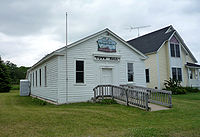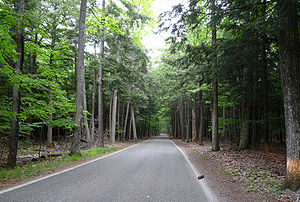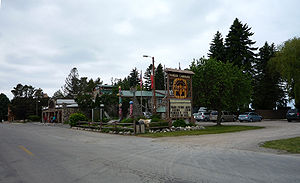
Cross Village Township, Michigan
Encyclopedia
Cross Village Township is a civil township
of Emmet County
in the U.S. state
of Michigan
. As of the 2000 census
, the township population was 294.
In the 2010 Census there was a Census Designated Place of Cross Village. It had a population of 93. The racial and ethnic composition of the population was 87.1% white, 1.1% African American and 11.8% Native American.
.
 Early records say that Father Jacques Marquette
Early records say that Father Jacques Marquette
, the famous French
Jesuit who endeared himself to the Native Indian population of Northern Michigan, planted a huge white cross on the bluff overlooking Lake Michigan before his death in 1675. As late as 1787, as many as twenty tribes populated the region and met here around tribal council fires. To the Native Indians who populated the numerous historic missions in the area, Cross Village became known as the "Land of the Cross." To the French, this region was known as L'Arbre Croche; to the Ottawas, it was called "Wau-gaw-naw-ke-ze"; and to the White man at the time, it was simply known as "Land of the Crooked Tree."
Bishop
Frederic Baraga
is another individual with historical ties to Cross Village. Baraga left a comfortable, aristocratic existence behind when he left Slovenia
. He arrived in Michigan in 1830 to serve the Native population and isolated small communities of this region. He spoke and developed written Native languages and is credited for spreading the Gospel among the local Ottawas and Ojibwe. In 1853, Baraga was elevated to Bishop, becoming the first Bishop in Upper Michigan.
Father Francis Xavier Pierz
, Bishop Baraga's friend and fellow Slovenian, was also assigned to Cross Village for many years. Father Pierz, however, was bothered by the increasingly settled nature of the region and departed for the newly organized Minnesota Territory
in 1852.
In an 1855 Emmet County was reorganized and four new townships were created by the State. One of them was "La Croix," which was officially changed its name to Cross Village in 1875.
The Holy Cross Church which had primarily Ojibwe members was operational until at least 1930.
Today, a replica of Father Marquette's cross stands at the edge of the bluff and is visible off the shore, far into Lake Michigan. Every year a small garden at the base of the cross is lovingly tended by the small town's garden club.
 The "Tunnel of Trees
The "Tunnel of Trees
", a breathtaking scenic drive down the winding Lake Michigan shoreline runs between Cross Village and Harbor Springs to the south. The drive is famed for its fall color scenery.
Cross Village is also home to Blissfest and the annual pow wow. Blissfest is a summer folk music festival that draws participants from across the nation, it takes place on the Festival Farm on Division Rd.
 The Cross Village area is also a protected nesting ground for the endangered piping plover.
The Cross Village area is also a protected nesting ground for the endangered piping plover.
, the township has a total area of 10.2 square miles (26.4 km²), of which, 10 square miles (25.9 km²) of it is land and 0.2 square mile (0.517997622 km²) of it (2.05%) is water.
As of the census
of 2000, there were 294 people, 132 households, and 86 families residing in the township. The population density
was 29.3 per square mile (11.3/km²). There were 280 housing units at an average density of 27.9 per square mile (10.8/km²). The racial makeup of the township was 84.69% White, 8.84% Native American, 1.02% Asian, 0.68% Pacific Islander, 0.34% from other races
, and 4.42% from two or more races. Hispanic or Latino of any race were 1.02% of the population.
There were 132 households out of which 15.2% had children under the age of 18 living with them, 56.8% were married couples
living together, 5.3% had a female householder with no husband present, and 34.1% were non-families. 28.0% of all households were made up of individuals and 11.4% had someone living alone who was 65 years of age or older. The average household size was 2.20 and the average family size was 2.67.
In the township the population was spread out with 15.6% under the age of 18, 4.8% from 18 to 24, 28.9% from 25 to 44, 33.3% from 45 to 64, and 17.3% who were 65 years of age or older. The median age was 46 years. For every 100 females there were 116.2 males. For every 100 females age 18 and over, there were 112.0 males.
The median income for a household in the township was $46,364, and the median income for a family was $60,417. Males had a median income of $29,375 versus $25,000 for females. The per capita income
for the township was $32,535. About 14.3% of families and 20.0% of the population were below the poverty line, including 57.1% of those under the age of eighteen and none of those sixty five or over.
Civil township
A civil township is a widely used unit of local government in the United States, subordinate to, and geographic divisions of, a county. Specific responsibilities and the degree of autonomy vary based on each state. Civil townships are distinct from survey townships, but in states that have both,...
of Emmet County
Emmet County, Michigan
Emmet County is a county in the U.S. state of Michigan. As of the 2000 census, the population was 31,437. The county seat is Petoskey.The county was formed April 1, 1840, from Mackinac County. It was first named Tonedagana County and renamed Emmet County on March 8, 1843...
in the U.S. state
U.S. state
A U.S. state is any one of the 50 federated states of the United States of America that share sovereignty with the federal government. Because of this shared sovereignty, an American is a citizen both of the federal entity and of his or her state of domicile. Four states use the official title of...
of Michigan
Michigan
Michigan is a U.S. state located in the Great Lakes Region of the United States of America. The name Michigan is the French form of the Ojibwa word mishigamaa, meaning "large water" or "large lake"....
. As of the 2000 census
United States Census, 2000
The Twenty-second United States Census, known as Census 2000 and conducted by the Census Bureau, determined the resident population of the United States on April 1, 2000, to be 281,421,906, an increase of 13.2% over the 248,709,873 persons enumerated during the 1990 Census...
, the township population was 294.
Communities
- Cross Village is an unincorporated community in the township on a rise overlooking Lake MichiganLake MichiganLake Michigan is one of the five Great Lakes of North America and the only one located entirely within the United States. It is the second largest of the Great Lakes by volume and the third largest by surface area, after Lake Superior and Lake Huron...
at 45°38′32"N 85°02′15"W. M-119M-119 (Michigan highway)The current highway was designated in 1979, replacing the former route of M-131; the routing has remained unchanged since. This section of highway had been part of M-13 on July 1, 1919, when the state trunkline highway system debuted...
has its northern terminus here, with PetoskeyPetoskey, MichiganPetoskey is a city and coastal resort community in the U.S. state of Michigan. As of the 2000 census, the city population was 6,080. It is the county seat of Emmet County....
about 34 miles to the south along the Lake Michigan shore.
In the 2010 Census there was a Census Designated Place of Cross Village. It had a population of 93. The racial and ethnic composition of the population was 87.1% white, 1.1% African American and 11.8% Native American.
History
Cross Village, like many of the area small towns, was once a thriving center for lumber. Because of its location on the lakeshore it was also a fishing community. Cross Village is one of the oldest settlements in Michigan and today is known for its ties to the OttawaOttawa (tribe)
The Odawa or Ottawa, said to mean "traders," are a Native American and First Nations people. They are one of the Anishinaabeg, related to but distinct from the Ojibwe nation. Their original homelands are located on Manitoulin Island, near the northern shores of Lake Huron, on the Bruce Peninsula in...
.

Jacques Marquette
Father Jacques Marquette S.J. , sometimes known as Père Marquette, was a French Jesuit missionary who founded Michigan's first European settlement, Sault Ste. Marie, and later founded St. Ignace, Michigan...
, the famous French
France
The French Republic , The French Republic , The French Republic , (commonly known as France , is a unitary semi-presidential republic in Western Europe with several overseas territories and islands located on other continents and in the Indian, Pacific, and Atlantic oceans. Metropolitan France...
Jesuit who endeared himself to the Native Indian population of Northern Michigan, planted a huge white cross on the bluff overlooking Lake Michigan before his death in 1675. As late as 1787, as many as twenty tribes populated the region and met here around tribal council fires. To the Native Indians who populated the numerous historic missions in the area, Cross Village became known as the "Land of the Cross." To the French, this region was known as L'Arbre Croche; to the Ottawas, it was called "Wau-gaw-naw-ke-ze"; and to the White man at the time, it was simply known as "Land of the Crooked Tree."
Bishop
Bishop
A bishop is an ordained or consecrated member of the Christian clergy who is generally entrusted with a position of authority and oversight. Within the Catholic Church, Eastern Orthodox, Oriental Orthodox Churches, in the Assyrian Church of the East, in the Independent Catholic Churches, and in the...
Frederic Baraga
Frederic Baraga
Frederic Baraga, Servant of God was a Slovene American Roman Catholic missionary, bishop, and grammarian.-Early life:Frederic Baraga was born as Friderik Irenej Baraga in the manor house at Mala Vas no...
is another individual with historical ties to Cross Village. Baraga left a comfortable, aristocratic existence behind when he left Slovenia
Slovenia
Slovenia , officially the Republic of Slovenia , is a country in Central and Southeastern Europe touching the Alps and bordering the Mediterranean. Slovenia borders Italy to the west, Croatia to the south and east, Hungary to the northeast, and Austria to the north, and also has a small portion of...
. He arrived in Michigan in 1830 to serve the Native population and isolated small communities of this region. He spoke and developed written Native languages and is credited for spreading the Gospel among the local Ottawas and Ojibwe. In 1853, Baraga was elevated to Bishop, becoming the first Bishop in Upper Michigan.
Father Francis Xavier Pierz
Francis Xavier Pierz
Francis Xavier Pierz was a Roman Catholic priest and missionary to the Ottawa and Ojibwa Indians. Because he was also responsible for attracting large numbers of Catholic German Americans to settle in Central Minnesota, he is referred to as "The Father of the Roman Catholic Diocese of Saint...
, Bishop Baraga's friend and fellow Slovenian, was also assigned to Cross Village for many years. Father Pierz, however, was bothered by the increasingly settled nature of the region and departed for the newly organized Minnesota Territory
Minnesota Territory
The Territory of Minnesota was an organized incorporated territory of the United States that existed from March 3, 1849, until May 11, 1858, when the eastern portion of the territory was admitted to the Union as the State of Minnesota.-History:...
in 1852.
In an 1855 Emmet County was reorganized and four new townships were created by the State. One of them was "La Croix," which was officially changed its name to Cross Village in 1875.
The Holy Cross Church which had primarily Ojibwe members was operational until at least 1930.
Today, a replica of Father Marquette's cross stands at the edge of the bluff and is visible off the shore, far into Lake Michigan. Every year a small garden at the base of the cross is lovingly tended by the small town's garden club.

M-119 (Michigan highway)
The current highway was designated in 1979, replacing the former route of M-131; the routing has remained unchanged since. This section of highway had been part of M-13 on July 1, 1919, when the state trunkline highway system debuted...
", a breathtaking scenic drive down the winding Lake Michigan shoreline runs between Cross Village and Harbor Springs to the south. The drive is famed for its fall color scenery.
Cross Village is also home to Blissfest and the annual pow wow. Blissfest is a summer folk music festival that draws participants from across the nation, it takes place on the Festival Farm on Division Rd.

Geography
According to the United States Census BureauUnited States Census Bureau
The United States Census Bureau is the government agency that is responsible for the United States Census. It also gathers other national demographic and economic data...
, the township has a total area of 10.2 square miles (26.4 km²), of which, 10 square miles (25.9 km²) of it is land and 0.2 square mile (0.517997622 km²) of it (2.05%) is water.
Demographics
As of Census 2010 Cross Village Township had a population of 281. The racial and ethnic composition of the population was 81.9% white, 13.2% Native American (16.7% when those who reported both Native American and different races are included), 0.4% African American and 4.6% from two or more races. 1.1% of the population was Hispanic or Latino (all of whom were Mexican).As of the census
Census
A census is the procedure of systematically acquiring and recording information about the members of a given population. It is a regularly occurring and official count of a particular population. The term is used mostly in connection with national population and housing censuses; other common...
of 2000, there were 294 people, 132 households, and 86 families residing in the township. The population density
Population density
Population density is a measurement of population per unit area or unit volume. It is frequently applied to living organisms, and particularly to humans...
was 29.3 per square mile (11.3/km²). There were 280 housing units at an average density of 27.9 per square mile (10.8/km²). The racial makeup of the township was 84.69% White, 8.84% Native American, 1.02% Asian, 0.68% Pacific Islander, 0.34% from other races
Race (United States Census)
Race and ethnicity in the United States Census, as defined by the Federal Office of Management and Budget and the United States Census Bureau, are self-identification data items in which residents choose the race or races with which they most closely identify, and indicate whether or not they are...
, and 4.42% from two or more races. Hispanic or Latino of any race were 1.02% of the population.
There were 132 households out of which 15.2% had children under the age of 18 living with them, 56.8% were married couples
Marriage
Marriage is a social union or legal contract between people that creates kinship. It is an institution in which interpersonal relationships, usually intimate and sexual, are acknowledged in a variety of ways, depending on the culture or subculture in which it is found...
living together, 5.3% had a female householder with no husband present, and 34.1% were non-families. 28.0% of all households were made up of individuals and 11.4% had someone living alone who was 65 years of age or older. The average household size was 2.20 and the average family size was 2.67.
In the township the population was spread out with 15.6% under the age of 18, 4.8% from 18 to 24, 28.9% from 25 to 44, 33.3% from 45 to 64, and 17.3% who were 65 years of age or older. The median age was 46 years. For every 100 females there were 116.2 males. For every 100 females age 18 and over, there were 112.0 males.
The median income for a household in the township was $46,364, and the median income for a family was $60,417. Males had a median income of $29,375 versus $25,000 for females. The per capita income
Per capita income
Per capita income or income per person is a measure of mean income within an economic aggregate, such as a country or city. It is calculated by taking a measure of all sources of income in the aggregate and dividing it by the total population...
for the township was $32,535. About 14.3% of families and 20.0% of the population were below the poverty line, including 57.1% of those under the age of eighteen and none of those sixty five or over.

